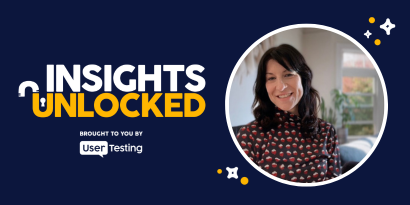
Episode 34 | March 07, 2022
Customer-first UX research at T. Rowe Price
Discover how T. Rowe Price uses UX research to improve customer experience, boost conversions, and scale empathy across teams with Harsha Thayi.
Building customer-first UX research strategies: A story of insight and impact at T. Rowe Price
Imagine you're trying to open a new investment account, and just as you step through the virtual front door, you're met with uncertainty—no roadmap, no signposts, just a form asking for your personal information. You hesitate. You bounce. You’re not alone.
This was exactly the challenge Harsha Thayi, senior manager of UX research at T. Rowe Price, uncovered when a newly launched account setup experience saw a surprising 37% drop-off on the very first page.
“We were so razor-focused on the account opening flow," Harsha said, "we forgot to look at what leads into it.”
In this episode of Insights Unlocked, Harsha walks us through how his team turned an unexpected setback into a pivotal moment for embracing UX research, scaling human insight, and building more empathetic, customer-centric digital experiences.
Why UX research must look beyond the obvious
At first glance, the drop-off issue seemed baffling. The page was simple—just four fields: name, age, email, and investment amount. The team had tested it with over 75 users during 16 weeks of sprints. Everything appeared to be on track. But something wasn't clicking.
Rather than doubling down on their assumptions, Harsha and team quickly launched an unmoderated user testing study to capture real-time feedback from prospective users. What they found reshaped their understanding:
“We hadn’t considered the context—the page before the experience. People wanted to know what to expect before entering their information. It was a blind spot.”
This is where the power of customer experience and user insights shines. UX research isn’t just about validating a design; it’s about uncovering the gaps in understanding between what we build and how real humans interact with it.
“As a customer, I don't care who owns what part of the process," Harsha said. "I just want to get the job done.”
A metaphor for UX: Navigating without a map
Think of a customer journey like navigating a new city. If you land at the airport with no idea where to go, even the best-designed metro system might leave you stranded. Similarly, even the most intuitive product interface can cause friction if the entry point isn’t clear.
By broadening their focus beyond the account form and into the surrounding experience, Harsha’s team quickly adapted. They added context to the landing page—what users needed, what to expect, and why it mattered. The drop-off rate dropped in turn.
Empathy is the secret ingredient in user testing
This experience sparked a deeper transformation across T. Rowe Price. Harsha’s team began advocating for empathy-driven UX research—helping stakeholders not just look at metrics, but understand the people behind the numbers.
“We had business KPIs like conversion rates, client effort scores, and satisfaction measures,” Harsha explained. “But we needed to bring the human element to those metrics.”
To that end, Harsha’s team launched an empathy program, where executives conducted one-on-one interviews with customers. The team also organized watch parties, where colleagues could view video clips of real user feedback and brainstorm solutions.
“It was powerful to see a senior product owner say, ‘We need to look at qualitative research, not just the data.’ That’s when we knew it was working.”
Harsha said storytelling and connecting with people is "so much more memorable than a pie chart or a dashboard.”
Democratizing research to scale impact
With a small UX research team of just two, Harsha knew they couldn’t handle every project request internally. So they shifted strategy—empowering product, marketing, and design teams to conduct their own studies.
Here’s how they made it happen:
- Pre-built screeners and audience templates
- Ready-made research scripts and note-taking guides
- Report templates to standardize findings
- Custom participant panels for niche user groups
By investing in research operations and scalable systems, T. Rowe Price was able to decentralize research without compromising quality. This not only improved agility but helped more teams develop a deeper understanding of their users.
“We don’t just want to do the research—we want to enable others to do it too.”
From segments to stories: humanizing customer personas
Another breakthrough came when the team realized there was no unified definition of their “target customer.” Different departments offered slightly different answers. That misalignment made it hard to create cohesive experiences.
This sparked an initiative to build broad-scope personas—turning abstract segments into relatable, research-based stories.
“We always had client segments," he said. "But they were just numbers. We needed to put a human face to them.”
These personas became a cornerstone for aligning cross-functional teams and anchoring decision-making in shared, research-backed understanding.
“We all have hypotheses, but we need to back them up with real human data,” Harsha said.
The road ahead: growing UX research maturity
Looking forward, Harsha is focused on evolving research maturity within the organization. Inspired by Jared Spool’s research maturity model, his team conducted an internal audit to understand where they stand—and where they need to grow.
What’s next?
- More advanced methodologies (e.g., longitudinal studies, field research)
- Continued development of empathy programs
- Stronger integration of qualitative and quantitative data
- Enhanced inclusivity in research practices
The ultimate goal? To embed human-centered design into every level of the business—from C-suite strategy to daily product decisions.
“The insight is the start of hundreds of ideas—it’s the spark that drives innovation.”
Why this matters for your team
Whether you’re a UX researcher, product manager, or marketing leader, Harsha’s journey at T. Rowe Price is packed with lessons:
- Don’t just optimize flows—optimize the context around them.
- Use human stories to complement hard data.
- Scale your team’s influence by enabling others to conduct research.
- Build alignment through shared understanding of your customer.
- Use empathy as a tool to inspire and unite teams.
At the heart of it all is a mindset shift: from designing for metrics to designing for people. When you understand your customers as humans—not just users—you unlock the potential to build better products, stronger relationships, and more impactful experiences.
“We need to think end-to-end, not in silos," Harsha said. "Because customers don’t care who owns what—they just want to get their job done.”









